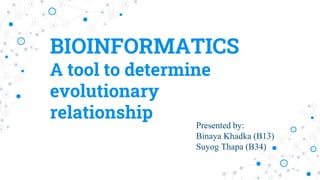Bioinformatics- Binaya&Suyog (1).pptx
•Download as PPTX, PDF•
0 likes•6 views
bioinformatic
Report
Share
Report
Share

Recommended
Recommended
More Related Content
Similar to Bioinformatics- Binaya&Suyog (1).pptx
Similar to Bioinformatics- Binaya&Suyog (1).pptx (20)
COMPUTATIONAL METHODS FOR FUNCTIONAL ANALYSIS OF GENE EXPRESSION

COMPUTATIONAL METHODS FOR FUNCTIONAL ANALYSIS OF GENE EXPRESSION
Evotec - How can Knowledge Graphs support Druh Discovery

Evotec - How can Knowledge Graphs support Druh Discovery
Recently uploaded
Recently uploaded (20)
NEWLETTER FRANCE HELICES/ SDS SURFACE DRIVES - MAY 2024

NEWLETTER FRANCE HELICES/ SDS SURFACE DRIVES - MAY 2024
Seismic Hazard Assessment Software in Python by Prof. Dr. Costas Sachpazis

Seismic Hazard Assessment Software in Python by Prof. Dr. Costas Sachpazis
8th International Conference on Soft Computing, Mathematics and Control (SMC ...

8th International Conference on Soft Computing, Mathematics and Control (SMC ...
Passive Air Cooling System and Solar Water Heater.ppt

Passive Air Cooling System and Solar Water Heater.ppt
01-vogelsanger-stanag-4178-ed-2-the-new-nato-standard-for-nitrocellulose-test...

01-vogelsanger-stanag-4178-ed-2-the-new-nato-standard-for-nitrocellulose-test...
History of Indian Railways - the story of Growth & Modernization

History of Indian Railways - the story of Growth & Modernization
Artificial intelligence presentation2-171219131633.pdf

Artificial intelligence presentation2-171219131633.pdf
Bioinformatics- Binaya&Suyog (1).pptx
- 1. BIOINFORMATICS A tool to determine evolutionary relationship Presented by: Binaya Khadka (B13) Suyog Thapa (B34)
- 2. Introduction ◎Interdisciplinary field that combines computer science, mathematics, and biology to analyze and interpret biological data. ◎Involves the development and application of computational methods, algorithms, and tools to store and understand biological data 2
- 3. Historical Overview Founder of Bioinformatics : Professor Margaret Dayhoff (1925-1983) • Emergence of Molecular Biology (1950s-1960s) • Development of Sequence Databases (1970s-1980s) • Rise of Genomics and Development of Computational Tools (1990s) • Next Generation Sequencing and Integration of Data Science and Machine Learning (2010s – present) 3 HGP
- 4. Bioinformatics and Evolutionary relationship Evolutionary relationships refer to the way that different species are related to each other through a common ancestor. How Bioinformatics helps in determining evolutionary relationship? Bioinformatics tools help us to compare genetic and genomic data from different species and identify similarities and differences in their DNA sequences 4
- 5. DNA Sequencing DNA sequencing allows us to read the order of nucleotides within a DNA molecule. It provides a means to read and analyze genetic information encoded in organism’s DNA. 5
- 6. Contd… ◎Sanger sequencing: Also known as dideoxy sequencing Involves electrophoresis and DNA replication using modified nucleotides that terminate the chain elongation process. 6
- 7. Contd… ◎Next-generation sequencing (NGS): Next-generation sequencing technologies revolutionized DNA sequencing by enabling high- throughput sequencing of millions of DNA fragments in parallel. 7
- 8. Sequence Alignment 8 Multiple sequence alignment may refer to the process or the result of sequence alignment of three or more biological sequences, generally protein, DNA, or RNA. -Importance of aligning DNA or protein sequences is to highlight the similarities and differences among the sequences. - MSA tools (ClustalW, MUSCLE): Aligning sequences to identify conserved regions and variations
- 9. 9
- 10. Study of evolutionary relationships among biological entities (species, individual or genes) Field of biology that focuses on reconstructing and studying the evolutionary history and relationships of organisms using genetic, morphological, and other relevant data. Phylogenetics 10
- 11. There are two main types of phylogenetic analysis: ◎ Molecular ◎ Morphological Molecular phylogenetics is based on comparing DNA or protein sequences, while morphological phylogenetics is based on comparing physical traits of organisms. The steps involved in phylogenetic analysis include selecting a set of organisms to study, collecting data (e.g., DNA or morphological data), performing sequence alignment, constructing a phylogenetic tree, and interpreting the results. Phylogenetic Analysis 11
- 12. A diagram with branches that displays the evolutionary relationships between different biological species. Phylogenetic tree 12
- 13. Construction of phylogenetic trees using sequence alignment data 13
- 14. Contd…. 14 Phylogenetic analysis tools (PhyML,MEGA, PhyloBayes): Estimating evolutionary distances and generating trees
- 15. 15
- 16. Comparative Genomics 16 Comparative genomics is a field of study that involves comparing and analyzing the genome sequences of different organisms to understand their evolutionary relationships, genetic variations, and functional elements. Helps in deciphering the genetic basis of traits, understanding evolutionary events, and studying the organization and evolution of genomes across species. Whole-genome alignment tools (GSAlign, LASTZ)
- 17. Molecular evolution 17 Process of change in sequence composition of cellular molecules(DNA,RNA and proteins) across generations. It encompasses various methods and approaches, including comparative genomics, phylogenetics and population genetics. -Substitution models (Jukes-Cantor, Kimura): Estimating rates of DNA/protein evolution - Detecting positive selection using tools like PAML
- 18. Implications for various fields 18 • Drug Discovery and Development • Agriculture and Crop Improvement • Biotechnology and Industrial Applications
- 19. Challenges and Future directions 19 Some Limitations in bioinformatics: Data Quality and Standards Big Data Management Privacy and Security Reproducibility and Data Sharing Future direction / Ongoing advancement in bioinformatics: Multi-omics Integration Integration of Clinical and Genomic Data Machine learning and artificial intelligence
- 20. 20 THANK YOU FOR YOUR ATTENTION ! Any questions?